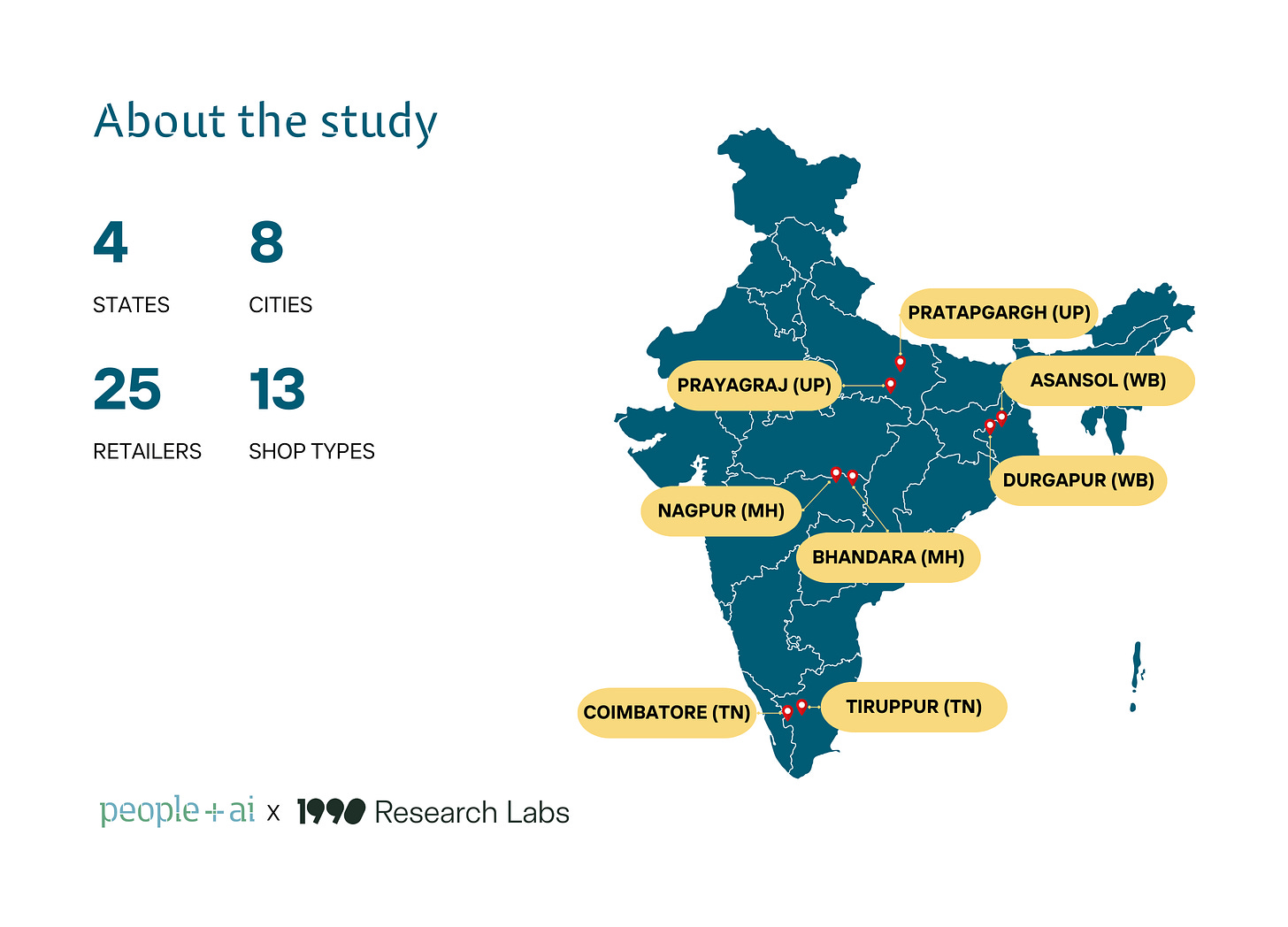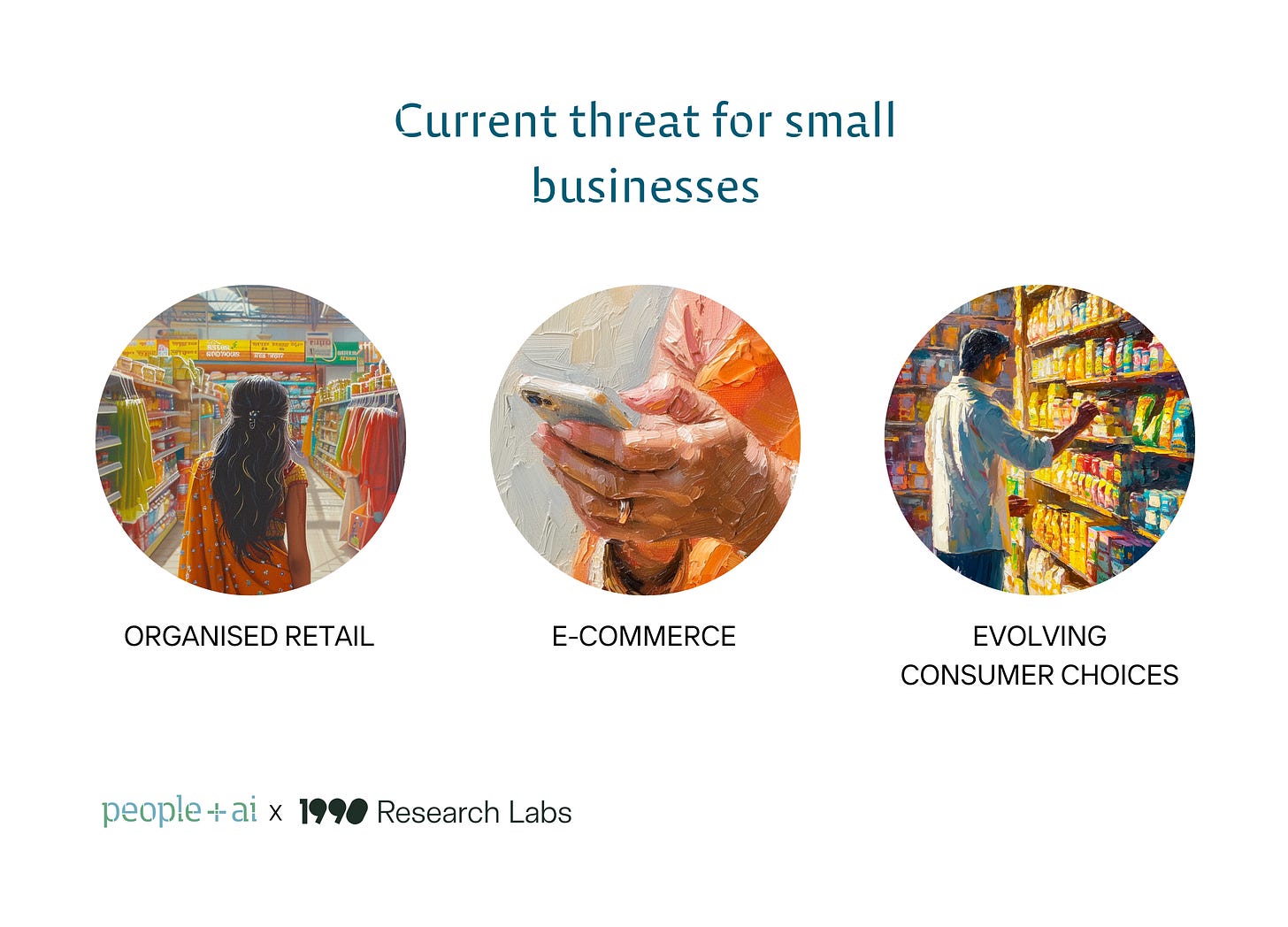How can GenAI help Indian SMEs?
New research series on Indian small businesses
Ever wondered how your beloved local shop manages to navigate the ever-changing business landscape dominated by large conglomerates and the rise of e-commerce? Have you ever been amazed by their survival strategy?
Welcome to the inaugural edition of our research series, "People's Voice: A Series on Uncovering Opportunities for AI in Small Businesses." This series is the outcome of a project 1990 Research Labs embarked on in collaboration with People + AI.
As a part of our research, we interviewed 25 small business owners across 5 Indian states to understand their current challenges of running retail businesses to find potential opportunities for AI to improve their lives.
Edition 1 will serve as a primer, providing insights into our decision to focus on AI and offering a glimpse into the world of small businesses. Subsequent editions will delve into the themes derived from interviews, exploring how these businesses operate, identifying pain points, and examining the potential for AI integration to enhance outcomes.
Introduction
In the era of instant access to everything with a click, there's a persistent habit—when a crucial item runs out at home, especially in emergencies, we instinctively rush to the trusted local shop.
Though largely unorganised, SMEs account for around 30% of GDP and employ 11.1 crore people in India. Despite the ongoing wave of digitization in various industries, these SMEs have yet to fully embrace it. Numerous startups aim to bring these businesses into the digital space, but their efforts often fall short. Why is that?
This is because the personal lives of these SME owners are deeply intertwined with their businesses. They find comfort in their chaotic and unorganised existence. They view this lack of structure not as a drawback but as necessary flexibility, enabling quick adaptation to changing circumstances.
In this context, these businesses fear that digital solutions may lack the adaptability and flexibility they are accustomed to. The benefits of digital solutions don't appeal to them due to perceived challenges in the learning curve and resource investment needed for implementation and maintenance.
Moreover, they believe that introducing digital solutions requires additional personnel, creating more friction than efficiency. These challenges are amplified for smaller businesses with limited manpower and financial resources. However, if small businesses have to survive the onslaught of competition, it is crucial for them to adopt digital technologies.
Role of Generative AI
Large Language Models (LLMs) present a remarkable opportunity for small and medium enterprises (SMEs) to optimize their operations and unlock valuable time for strategic business planning. Conventional technological solutions often come with a steep learning curve, which can hinder SMEs from realizing their full potential and lead to a lack of confidence in their effectiveness. However, GenAI's unique ability to comprehend and navigate unstructured, chaotic environments bridges the gap between context and utility, making it an ideal fit for SMEs.
AI sets itself apart from conventional methods by eliminating the need for manual data entry. Instead, it can quickly process and analyze vast amounts of unstructured data, enabling businesses to gain valuable insights and make informed decisions more rapidly. The adoption of GenAI could be a pivotal moment for the MSME sector, ushering in a new era of efficiency, competitiveness, and innovation.
Understanding small businesses
When considering starting an e-commerce business, the Total Addressable Market (TAM) can be as vast as an entire country. However, small retailers often have a different perspective, viewing their neighborhood as their potential TAM. The majority of their prospective customers reside within a 5 km radius, leading these retailers to value each customer equally. Their goal is to convert every store visitor into a lifelong customer and eventually attract their family members and relatives through exceptional service and word-of-mouth marketing. For these business owners, a customer leaving empty-handed is considered a failure, as they prioritize building relationships over mere transactions.
Many small business owners establish their stores to gain independence from working for others. Their business objectives are closely intertwined with personal goals, such as purchasing a home, paying for their children's education, or arranging their marriages. Due to their limited trust in hiring and training employees, these owners become the central figure in running the business, often without proper processes or documentation. The business owner essentially becomes the operating system of the shop, and the business may cease to exist in their prolonged absence.
While SMEs have weathered business challenges in the past by adapting to the changing world, they currently find themselves at a critical juncture. They face existential threats from e-commerce, organized retail, and evolving consumer preferences. Although they recognize the importance of growth and innovation for continued success, they often struggle to map out a clear path for growth. Technology may hold the key to addressing this challenge and helping SMEs navigate this pivotal moment in their journey.
Three types of businesses
Are you curious about the key differentiators that set small businesses apart? We have identified three distinct categories of SMEs, each with their own unique selling proposition (USP) that defines their competitive edge in the market.
Curation business
Curation businesses are characterized by meticulous business owners who carefully select, create, or assemble distinctive products that cater to the specific needs and preferences of their customers. The unique selling point of these businesses lies in the proprietor's discerning taste and expertise. A prime example of a curation business is a women's boutique store, where the owner's keen eye for fashion and ability to curate a tailored collection sets the business apart from competitors.
Aggregation business
Aggregation businesses provide customers with the convenience of accessing a wide range of products and brands in a single location. These businesses prioritize the ease of product availability, making it simple for customers to find what they need. The majority of items sold in aggregation businesses are standard stock keeping units (SKUs) sourced from various brands. Grocery stores and stationery stores are prime examples of aggregation businesses. In these establishments, customers place their trust not only in the brands offered but also in the store owner's recommendations, creating a dual layer of trust that drives customer loyalty.
Monopoly business
In this type of business, the proprietor secures exclusive rights to sell products from a specific brand, which they source directly from the distributors. This exclusivity agreement provides them with a competitive edge, as it eliminates direct competition and prevents customers from comparing their offerings with other stores in the area. To establish this exclusivity, the store owner enters into a contract with the distributor, ensuring that the same brand is not supplied to any other store within a specified geographical range. In return, the store owner pledges to generate significant business for the brand by leveraging their local connections and networks.
A prime example of this business model is an electrical store we came across in Pratapgarh (UP). The owner had secured the exclusive rights to sell the RR Kabel wire brand in the area. By utilizing his strong local ties with electricians, the store owner was able to ensure that they actively promoted and recommended the RR Kabel brand for residential use. This strategic partnership not only benefited the store owner but also helped the brand gain a strong foothold in the local market.
Although businesses can be classified into three distinct categories, it is not unusual for a single business to operate across multiple categories simultaneously. For example, consider a fashion boutique that offers a carefully curated selection of kurtis, positioning itself as a curator business. However, the same boutique may also stock standard undergarments from various brands, effectively functioning as an aggregator business in that product category.
These examples illustrate how businesses can strategically leverage different business models for various product categories, enabling them to create a unique market position that caters to the diverse needs and preferences of their customers.
Look forward
In our comprehensive study, we conducted in-depth interviews with participants, covering a wide range of topics, including business establishment, operations, and expansion strategies. Over the next 10 editions, we will delve deeper into each of these specific areas. From the initial stages of setting up a business to the day-to-day operations and the complex process of expanding and growing the enterprise, we will cover it all. So, stay tuned as we embark on this exciting journey of discovery and learning!
The full report of this study is available to read here 👇
If you are excited about building AI solutions for India, join the People+AI WhatsApp group to brainstorm ideas and attend exclusive events.









Super
Interesting blog.
However, it doesn't answer the question asked in the title.
In the categorisation of business, for monopoly business, another way to look at them can be that these businesses where the buying decision is significantly influenced by third parties. For instance, when purchasing electrical items, customers often rely on recommendations from electricians.
The nature of the business might not always be monopolistic.